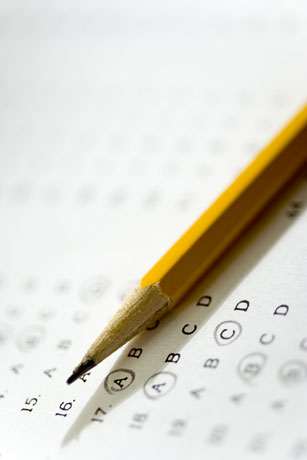 Algebra quizzes. Standardized tests. SATs. Like it or not, tests count. Everything that goes on in a classroom is influenced by test performance, says Kathleen Vasquez, literacy and social studies program manager for Seattle Public Schools. “I tell underperforming kids, ‘Try your very best on every test, because you never know how they’ll use that test.’”
Algebra quizzes. Standardized tests. SATs. Like it or not, tests count. Everything that goes on in a classroom is influenced by test performance, says Kathleen Vasquez, literacy and social studies program manager for Seattle Public Schools. “I tell underperforming kids, ‘Try your very best on every test, because you never know how they’ll use that test.’”
Many schools “teach to tests” these days; they determine what they’ll teach based on what standardized tests cover, hoping students’ scores will climb. And with the number of kids applying to college continuing to increase, SAT and ACT scores matter more than ever, says Colin Gruenwald, director of SAT and ACT programs at Kaplan Test Prep in New York.
What about the kids who just can’t seem to take tests? Maria Thompson’s son Eli, a middle school student, fails just about every test he takes, says Thompson, an Edmonds resident. “If he studies and he’s aware of what might be on test, he does a lot better, but in general, he does terribly.” Eli, diagnosed with attention deficit hyperactivity disorder, takes meds that help somewhat. However, says Thompson, “He still doesn’t do very well.”
Eric Anderson, manager of research evaluation and assessment for Seattle Public Schools, says kids — even students who find tests challenging — need to learn how to perform on tests. “I tell families that testing is demonstrating skills under pressure. They have to accept that part of life is performing under pressure,” he says.
Learning to study
How can kids learn test-taking skills? For day-to-day quizzes and tests, teaching kids to study can make a big difference, says Sara Kuhl, founder and author of the Brain Camp curriculum, a program that promotes and teaches study skills.
“Start with a place to study,” Kuhl says. “Your environment is powerful in effective learning. We all have places where we pull our thoughts together. Where can you go to reliably focus and do work? Starbucks? The kitchen? The library?”
Most students don’t study in ways that work for them, says Kuhl. “Every conceivable combination of learning styles and abilities appears in every classroom. Kids will reread their book and repeat the information in their notes, but that only works if they have a strong ability to remember what they’ve heard and read. Less than 15 percent of the population has that.”
Kuhl suggests parents find out what type of learner their child is, and then tailor his study style to his strengths. For example, visual learners think in pictures. Creating a pictorial graph, web or other picture of the information those students need to know will help them remember it during a test. “They can snag that picture as opposed to seeing words on a page that don’t penetrate their brain,” Kuhl says.
“My son’s teacher told me that he’s a tactile learner,” says Thompson. “He learns better with manipulatives to learn math and by writing things down. With word problems, it helps when he’s got something to look at. With spelling tests, we’d get up and clap and stomp the letters. His teacher said to get up and start saying spelling words, walk them out, so that he can feel them.”
Parents can also use “chunking,” which means boiling down information into smaller chunks. “Kids who struggle in school are often right-brain dominant — big-picture people — and can’t chunk down information. They’re not sippers of information, they’re gulpers,” says Kuhl.
Kuhl recommends a note-taking system called Cornell Notes. Kids take notes in class on the right side of a notebook page, and when they study, they extract the main concepts, listing them on the left side of the page.
Since many kids struggle with time and planning, Kuhl also suggests “back planning”: planning out study time and study partners on a calendar. “People absorb information better when they get it in small doses,” she says. Parents can also help kids study by creating posters with the concepts their children are studying and making diagrams of the information they’ll need (for example, a picture depicting the branches of the government), so they can recall the picture instead of just words on a page, she says.
Taking college entrance tests
For college entrance tests like the SAT, practice is key. “Give it a chance. Find out how you do,” says Gruenwald. “Kids need to know what the test is going to be before they have the impression of how they’ll do on it.”
Gruenwald says kids should take the actual SAT or ACT more than once. “Familiarity with the structure and the experience will make them better test takers,” Gruenwald says.
What can parents do to help their kids improve their scores? Talk to them — and use big words. “Use vocabulary above your child’s reading level, but always be defining your words, so they’re exposed to that language more often,” says Vasquez. “Ask them, ‘What are you reading about?’ Have conversations often about reading. Read an article and talk about it. These are smooth, easy ways to support kids in testing.”
Kids can work on their attitude and assets, and develop their own motivation to improve their test-taking skills, says Anderson. “Unlike other countries, how you do on a test at 12 or 13 doesn’t determine your future. We make allowances for the late bloomer; people can reinvent themselves. At the end of the day, there’s no single test that’s going to define you, or make or break a student in the grand scheme of things. Our culture really values improvement.”
Maria Bellos Fisher is a parenting and business writer, blogger and mom. She scored 1100 on the SAT.











